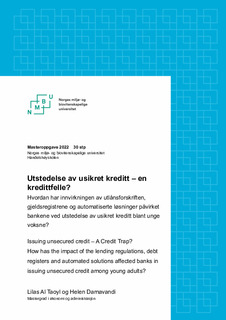| dc.contributor.advisor | Worren, Nicolay Andre Melsæter | |
| dc.contributor.author | Damavandi, Helen | |
| dc.contributor.author | Taoyl, Lilas al | |
| dc.date.accessioned | 2022-09-21T12:40:21Z | |
| dc.date.available | 2022-09-21T12:40:21Z | |
| dc.date.issued | 2022 | |
| dc.identifier.uri | https://hdl.handle.net/11250/3020240 | |
| dc.description.abstract | Tidligere var det en stor utfordring at unge voksne hadde mye gjeld. I dag har gjeldsgraden blant unge voksne blitt redusert betraktelig etter at gjeldsregistrene tredde i kraft i 2019 og de nye endringene i utlånsforskriften som kom i 2020. Oppmerksomheten rundt usikret kreditt innenfor norsk finanspolitikk blir stadig større da det er et viktig tema og gjelder mange mennesker. Nedstengninger og sosiale begrensninger som følge av koronapandemien var også faktorer som har ført til at gjelden ble redusert betydelig. Med en strengere utlånspraksis og skjerpede krav har bankene fått strengere retningslinjer å følge når det gjelder innvilgelse av usikret kreditt. Gjeldsregistrene har ført til at bankene kan hente ut kundenes opplysninger selv og kan medføre til uønsket vekst i utlånene. I tillegg bidrar det automatiserte systemet med å gjøre det enklere for bankene å utøve innvilgelsespraksis.
Denne utredningen tar for seg hvordan innvirkningen av utlånsforskriften, gjeldsregistrene og automatiserte løsninger har påvirket bankene ved utstedelse av usikret kreditt blant unge voksne. Formålet med oppgaven er å undersøke på hvilken måte bankene anvender de ulike tiltakene, i tillegg til å kartlegge hvilken effekt tiltakene har hatt på usikret kreditt blant målgruppen. I arbeidet med disse spørsmålene ble det gjort bruk av både kvalitativ og kvantitativ metode. Datainnsamlingen ble gjort gjennom kvalitative intervjuer med totalt ti informanter hvorav fire av disse består av breddebanker og seks forbruksbanker. I tillegg ble kvantitativ metode brukt ved å innhente statistikker og data fra informantene og Finanstilsynet. Problemstillingen blir belyst av hovedfunnene i lys av relevant teori og forskningslitteratur.
Resultatene fra undersøkelsen viser at de ulike tiltakene har hatt en positiv innvirkning på bankenes utlånspraksis hvorav gjeldsregistrene har hatt en betydelig effekt av reduksjon i antall gjeldsofre. I tillegg har automatiserte løsninger påvirket bankene positivt da formålet har vært å legge til rette for mer presise kredittvurderinger og å forebygge gjeldsproblemer blant unge voksne. Videre har de nye retningslinjene for utlånsforskriften bidratt til en redusert forbruksgjeld og er med på å dempe risikoen for økende gjeld i norsk økonomi. Noen av informantene benytter frarådingsplikten og unngår å flytte risikoen over til kunden ettersom ikke alle er innforstått med hva fraråding innebærer. Det er årsaken til at bankene heller foretrekker å gi avslag enn å fraråde. | en_US |
| dc.description.abstract | In the past, the debt among young adults was a big challenge. However, the debt ratio among young adults today has been reduced considerably after the debt registers were introduced in 2019 and the new changes in the lending regulations that came in 2020. The awareness of unsecured credit in Norwegian fiscal policy is growing as it is an important theme that applies many people. Due to the corona pandemic and the restrictions that has followed, it has led to closures and social constraints which also led to a significant reduction in debt. With stricter lending practices and requirements, the banks have altered and been given stricter guidelines from the government to follow when granting unsecured credit. The debt registers have made an opportunity for the banks and the customers to be able to obtain customers information and contribute to unwanted growth in lending. In addition, the automated system provides to make it easier for the banks to practice granting practices.
This master thesis addresses how the impact of the lending regulations, debt registers and automated solutions has affected banks in issuing unsecured credit among young adults. The purpose of the thesis is to investigate in which way the banks apply the various measures, in addition to explore the effect the measures have had on unsecured credit among the target group. A qualitative and quantitative theory-driven case study has been used to find answers to these questions. The qualitative method was done through interviews with a total of ten informants, which four of them are national banks and six consumer banks. In addition, a quantitative method was used by obtaining statistics and data from the informants and The Financial Supervisory Authority (Finanstilsynet).
The results from the survey show that the various measures have had a positive impact on the banks' lending practices and the debt registers have had a significant effect of reducing the number of debt victims. Furthermore, the automated solutions have had a positive influence on banks as the purpose has been to facilitate more precise credit ratings and to prevent debt problems among young adults. Moreover, the new guidelines for the lending regulations have contributed to a reduction in consumer debt and are helping to reduce the risk of increasing debt in the Norwegian economy. Some of the informants use the dissuasion obligation and avoid transferring the risk to the customer as not everyone understands what dissuasion entails. Likewise, this is the reason why banks prefer to refuse an application for unsecure credit rather than advise against. | en_US |
| dc.language.iso | nob | en_US |
| dc.publisher | Norwegian University of Life Sciences, Ås | en_US |
| dc.rights | Attribution-NonCommercial-NoDerivatives 4.0 Internasjonal | * |
| dc.rights.uri | http://creativecommons.org/licenses/by-nc-nd/4.0/deed.no | * |
| dc.title | Utstedelse av usikret kreditt - en kredittfelle? : hvordan har innvirkningen av utlånsforskriften, gjeldsregistrene og automatiserte løsninger påvirket bankene ved utstedelse av usikret kreditt blant unge voksne? | en_US |
| dc.title.alternative | Issuing unsecured credit – a credit trap? : how has the impact of the lending regulations, debt registers and automated solutions affected banks in issuing unsecured credit among young adults? | en_US |
| dc.type | Master thesis | en_US |
| dc.description.localcode | M-ØA | en_US |

